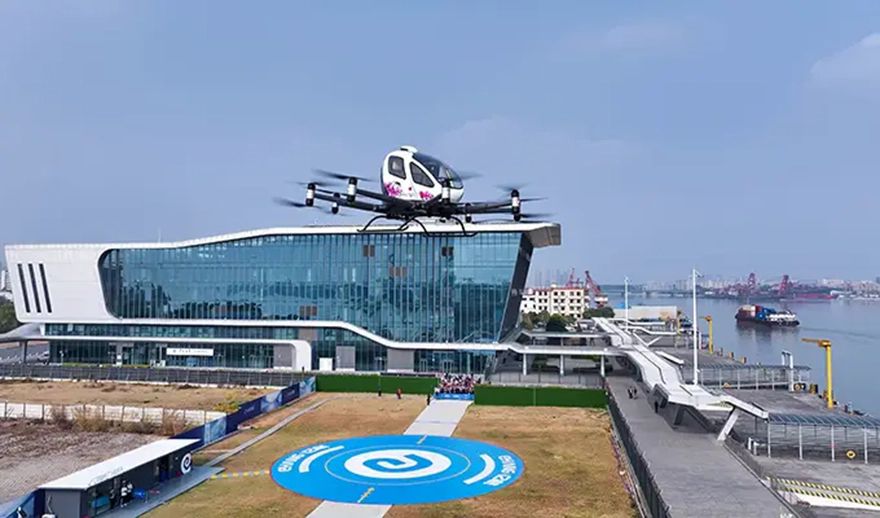 Customers in the Chinese cities of Guangzhou and Hefei can purchase tickets for a tourism or sightseeing flight in EHang’s self-flying EH216-S. Photo: EHang
Customers in the Chinese cities of Guangzhou and Hefei can purchase tickets for a tourism or sightseeing flight in EHang’s self-flying EH216-S. Photo: EHangA crop of American aircraft manufacturers has poured billions of dollars in venture capital into a design they believe will fundamentally change the way people move through cities — the electric vertical take-off and landing (eVTOL) air taxi. As soon as this year, the aircraft could begin flying passengers in cities such as New York, Chicago, and Los Angeles. But the first eVTOL to carry paying customers will debut in China.
In a major development for the industry, eVTOL manufacturer
EHang last week said the Civil Aviation Administration of China (CAAC) has awarded air operator certificates to its subsidiaries EHang General Aviation in Guangzhou and HeYi Aviation in Hefei. The initial approvals authorise the world’s first human-carrying operations with an electric, autonomous aircraft: EHang’s EH216-S. Customers in Guangzhou and Hefei can now buy tickets for aerial tourism, sightseeing, and experiential flights.
EHang said the air operator certifications give it the ‘full suite’ of regulatory approvals needed to run an eVTOL air taxi business. The company earned the world’s first eVTOL type certificate from CAAC in 2023 and subsequently secured production and airworthiness approvals. CAAC earlier this year also approved a four-seat electric aircraft for commercial service.
In the USA, flight schools are using Pipistrel’s Velis Electro, and a handful of customers have gotten their hands on Pivotal’s BlackFly, a personal eVTOL model. But no eVTOL design has been authorised by the FAA for commercial passenger service. Early EH216-S operations will come with heavy limitations, which EHang said it aims to lift in phases.
Flights are restrictedFor example, flights are restricted to Guangzhou and Hefei and must land where they lifted off. The firm said it is working with CAAC to enable flights between different locations and expand the number of hubs in its network. On Sunday, it shared images of operation centres in Shenzhen, Zhuhai, Taiyuan, and other major cities.
The operator certificates also authorise ‘human-carrying’ operations rather than the more permissive ‘passenger transport’. According to EHang, the latter services follow public routes, are regularly scheduled, cannot be arbitrarily cancelled, and sell tickets through public platforms. Human-carrying operators, by contrast, use private routes, offer nonscheduled trips, and sell tickets through their own dedicated channels.
In other words, the EH216-S is approved for applications like out-and-back aerial tourism but not air taxi services in cities. Ultimately, the goal is to bring the two-seater to urban areas to create what Chinese officials have termed the low-altitude economy.
EHang said in a news release: “The human-carrying pilotless aviation and the low-altitude economy, as an emerging industry, is still in its developmental stage and remains a national strategic focus in China’s aviation sector. There are still many challenges to be addressed and improvements to be made, requiring industry-wide collaborations.”
State-led approachChina’s vision for the low-altitude economy resembles the FAA’s Innovate28 plan to introduce eVTOL air taxis and other new designs at scale in the US by 2028, with a few key distinctions. For one, China has elected to certify self-flying models, such as the EH216-S and AutoFlight’s Prosperity, before turning to crewed operations. Chinese manufacturers have also benefitted from the country’s state-led approach, with financial support and incentives from government at all levels.
By contrast, the FAA is set to introduce crewed eVTOLs before certifying self-flying designs like Boeing-owned Wisk Aero’s Generation 6. The US industry is largely privately backed, with developers such as Joby Aviation and Archer Aviation garnering billions of dollars in investments. The US Department of Defense — through its innovation arm AFWERX — has funded some development and testing of eVTOL models, though not nearly at the scale of the Chinese government.
The US military will likely be the first to get its hands on an eVTOL designed for commercial passenger service. Archer, for instance, recently launched a defence business and is teaming with Anduril and Palantir to develop what it describes as a ‘next generation’ aircraft for the DoD.
Routine eVTOL air taxi services, though, are waiting on FAA certification and the development of infrastructure such as vertiports and charging stations. SMG Consulting’s AAM Reality Index — which tracks manufacturers’ progress toward scaled production — rates Archer and Joby’s chances of meeting their 2025 commercial launch targets as ‘highly unlikely’.